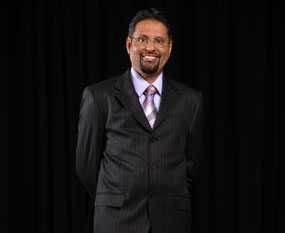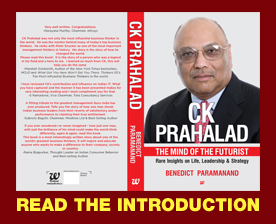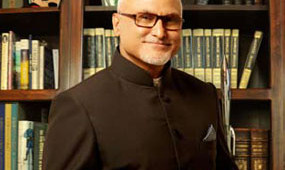 Social Entrepreneur Chenraj Roychand, Chairman and Chancellor, Jain University
Social Entrepreneur Chenraj Roychand, Chairman and Chancellor, Jain University
Enter the modest cabin of Chenraj Roychand you will see him scribbling something minutely on a notebook. You’d remember school days when you were asked to write a sentence you forgot to recite a hundred times as a punishment. You get curious and ask him what he is up to; he flashes the notebook as if he’s set a record. He’s already completed three fourths of the book, and in each page, he’s written Om Sai Ram about 2,000 times. Wondering if you’ve landed in a wrong place, you look around and see a calendar of Shirdi Sai Baba hang close to his desk as if the saint is keeping an eye on him.
Why would a chancellor of a university of 50,000 students, want to do that, you wonder. Without trying to find the right expression, he says: “I write Om Sai Ram as I don’t want to keep myself idle. I feel empty mind is a devil’s workshop. So I think by writing this, I think positively. It gives me calmness; I am in control of myself. If I don’t write, I might interfere and be like a super boss. They (staff) are empowered people, why should I doubt them?” Chenraj’s target is to write the chant more than ten million times. “These things come from within. Definitely being connected gives you some solace,” he adds. Does he have the time to be idle? He must either be a master in delegating responsibilities and or is simply self indulgent.
If you’d gone to meet Chenraj expecting him to be like a typical Marwari who will flaunt his trophies, you’d be disappointed. As he warms up, he does show pride in what he’s achieved in 33 years since he started a college of 36 students and six teachers in 1990 in a hall in Bangalore. Why not, if 60 percent of the 50,000 students he educates each year are poor from small town India, he’s doing a remarkable job. Jain institutions run subsidized and free schools in three districts spread across Rajasthan, Madhya Pradesh and Karnataka.
In a poor country, where he believes only 15 percent can really read and write, as against the government’s claim of 70 percent, his mission is to fight poverty through education. His goal is to provide free education to half a million students in 10 years.
Entrepreneurs’ Entrepreneur
Next to education, his passion is nurturing entrepreneurship. He is not really from an entrepreneur or a man from a business family. His grandfather was an accountant at the turf club in Bangalore and his father, after a brief stint as a clerk in the Reserve Bank of India, opened a textile distribution shop. This didn’t interest Chenraj. He had been struck hard by scenes of children loitering on the streets in small Indian towns aimlessly when he used to go with his father on business trips. He remembered Swami Vivekananda’s call, every time he saw a poor child, to every Indian to rid the country of the curse of poverty and only then can it hold its head high amongst nations. Until then, all the talk about rich culture and its shining monuments made no sense.
With his father’s support of Rs. 50,000 in 1990, young Chenraj started his education venture with only passion as his real capital. Marwari traits of frugality and non-confrontational approach to life saw him grow steadily as one of Bangalore’s dynamic educationists. Bangalore’s rich education culture and the information technology boom propelled the Jain Group of Institutions to a leadership role especially among the new institutions. Chenraj’s red letter day came when his group of institutions obtained the deemed university status in 2008.
Nurturing social entrepreneurs is Chenraj’s second passion. He has already incubated 56 companies which are in various business sectors and in 15-20 verticals. His grand plan is to nurture 8, 800 entrepreneurs in his life time and expects all of them to create 2% of India’s GDP, which, given India’s expected growth, could be at least $ 60 billion, out of $ 3 trillion. A tall order, indeed!
His formula seems simple. He says: “Our umbrella organization (JGI) will have entrepreneurs in training. We plan to grow 100 entrepreneurs a year. The day we complete 500 entrepreneurs in the next 5-7 years, they will replicate this model pan India.” Where does he find the money to fund them? The Jain Foundation will hold 50 percent stake in the companies it incubates and profits will be ploughed back.
Satsang Management Style
Is Chenraj Roychand a graduate from Harvard or a Stanford or from any of India’s IIMs, if he’s risen so tall? “I have just passed 8th standard but have made efforts to study for masters in English Literature,” says Chenraj without any remorse. His English is good and, as every achiever would say, ‘if you have substance and you are passionate, language comes naturally to your lips.’ Chenraj even teaches entrepreneurship in business schools. Mangalore University has also recognized his contribution to education and granted him an honorary doctorate degree in 2010. So, you don’t need to study too hard to get a doctorate. You can earn it, as well.
So, what’s his secret management philosophy? The best way to find that out is to ask how many people who joined his institutions ten years ago are still with him. As if he expected this question, he reeled out the numbers – “I started with 6 people and then went on to become 100 that was the first team. Out of 100, 80 are there with us. Between the years 2000 and 2013, 4,000 people joined us. Out of them 3,600 are still with us. Our strength is human capital and the average age of our team is 33.”
You press him further for the jargons, he has them in plenty: “So there is ownership and corporate responsibility, it’s empowered situational leadership. Strategically, yes, a broad guideline, a road map is created. W e adapt to the new changes of what is required as per the sector’s requirements. It’s a lean management with situational leadership style, so they are the bosses.”
Chenraj believes in following all the rules to stay out of trouble and adopting HR corporate best practices to retain his staff. “We define the visibility factor on the regulatory guidelines. Apart from that, everything is informal.”
He adds: “Empowered leaders are given the autonomy to function as a corporate thinker. They will be the leaders of that particular institute and are responsible for the entire relationship in the market, corporate, stakeholders, students, teachers, and the administration. They, in turn, will have to train their next level leaders and it’s a top down approach. You can say we are a flat organization run by situational leadership.”
Chenraj Roychand must be doing almost everything right to be in the position his institutions are today. He’s an inspiration to most Indians who tend to be easily cynical of the people and the systems around them and give up easily. India is what it is today because of a few hundred daring men and women who chose to beat the system not by trying to break it but by rising above it.











Recent Comments